Discover a delicious salamon recipe that’s ready in under 30 minutes. Learn how to make perfectly seasoned, flaky fish with simple ingredients for a healthy dinner
Every home cook faces the challenge of making a tasty, quick, and healthy meal. My journey with salmon recipes started on a crisp autumn evening. It was then that I realized how amazing this fish can be in the kitchen.
Salmon dishes are more than just meals; they’re culinary adventures. Whether you’re a busy professional or a home cooking enthusiast, salmon is perfect. It combines flavor and convenience, making it a great choice for any meal.
Key Takeaways
- Salmon is incredibly versatile and easy to prepare
- Quick cooking methods make salmon perfect for weeknight dinners
- Rich in nutrients and flavor, salmon suits many dietary preferences
- Multiple cooking techniques can be used for salmon dishes
- Minimal ingredients can create restaurant-quality meals
The Perfect Salmon Selection Guide
Choosing the right salmon can make your cooking better. Whether you’re making salmon fillets for dinner or looking for top-notch smoked salmon, knowing your options is key.
Salmon has many types, each with its own taste and cooking style. Picking the best fish means you’ll always have a tasty meal.
Exploring Salmon Varieties
There are five main Pacific salmon types:
- Chinook (King Salmon): Has the richest flavor and most fat
- Sockeye: Has a deep red color and strong taste
- Coho: Has a milder taste, great for beginners
- Pink: Is the lightest, and more affordable
- Chum: Is less fatty, perfect for grilling
Fresh Salmon Selection Tips
When buying salmon fillets, look for these signs of quality:
- Bright, even color without brown spots
- Firm flesh that springs back when pressed
- Clean, ocean-like smell
- Looks moist but not too wet
Wild vs. Farm-Raised Salmon
Knowing the difference between wild and farm-raised salmon helps you choose wisely:
- Wild Salmon: Caught in nature, better for the planet
- Farm-Raised Salmon: Always available, might be cheaper
« The quality of your salmon determines the success of your dish. » – Professional Chef
Pro tip: For the best smoked salmon, always choose fresh, high-quality fish from trusted sources.
Essential Ingredients for Flavorful Salmon
Starting a delicious salmon dish means picking the right seasoning and marinade. You need to know which ingredients turn simple fish into a gourmet meal.
For amazing salmon, choose top-notch ingredients that match its rich taste. A great marinade mixes acidic, sweet, and savory parts to boost the fish’s flavor.
- Fresh herbs like dill, parsley, and thyme
- Citrus elements such as lemon and orange zest
- Aromatic spices including garlic, paprika, and black pepper
- Healthy oils like olive oil or avocado oil
Now, let’s look at some classic salmon seasoning mixes that make your dish better:
| Flavor Profile | Key Ingredients | Best Cooking Method |
|---|---|---|
| Mediterranean | Oregano, lemon, garlic, olive oil | Grilling |
| Asian-Inspired | Soy sauce, ginger, sesame oil | Pan-searing |
| Cajun Spice | Paprika, cayenne, thyme, garlic powder | Blackening |
Marinating salmon needs care. Acidic marinades should not go over 30 minutes to keep the fish tender. You aim to add to, not overwhelm, the salmon’s taste.
Salmon Recipe: Honey Garlic Perfection
Discover a mouthwatering salmon recipe that will change your dinner game. This honey garlic salmon dish is a mix of sweet and savory. It’s a meal that’s both easy to make and fancy.
This recipe makes your baked salmon the main attraction. The honey, garlic, and fish come together for a tasty and healthy meal.
Sauce Preparation Tips
Making the perfect honey garlic sauce is all about balance. Here’s how to make a great salmon recipe:
- Combine fresh minced garlic with pure honey
- Add a splash of soy sauce for depth
- Squeeze fresh lemon juice for brightness
- Whisk ingredients until smooth and well-integrated
Cooking Time and Temperature
| Salmon Thickness | Baking Temperature | Cooking Time |
|---|---|---|
| 1-inch thick | 375°F | 12-15 minutes |
| 1/2-inch thick | 375°F | 8-10 minutes |
Pro tip: Use a meat thermometer to ensure your baked salmon reaches an internal temperature of 145°F for perfect doneness.
Serving Suggestions
Make your salmon recipe even better with the right sides. Try pairing it with:
- Roasted asparagus
- Cilantro lime rice
- Fresh green salad
- Quinoa pilaf
Your honey garlic salmon will wow your dinner guests. It’s a dish that tastes like it came from a fancy restaurant but is easy to make.
Quick Pan-Seared Salmon Technique
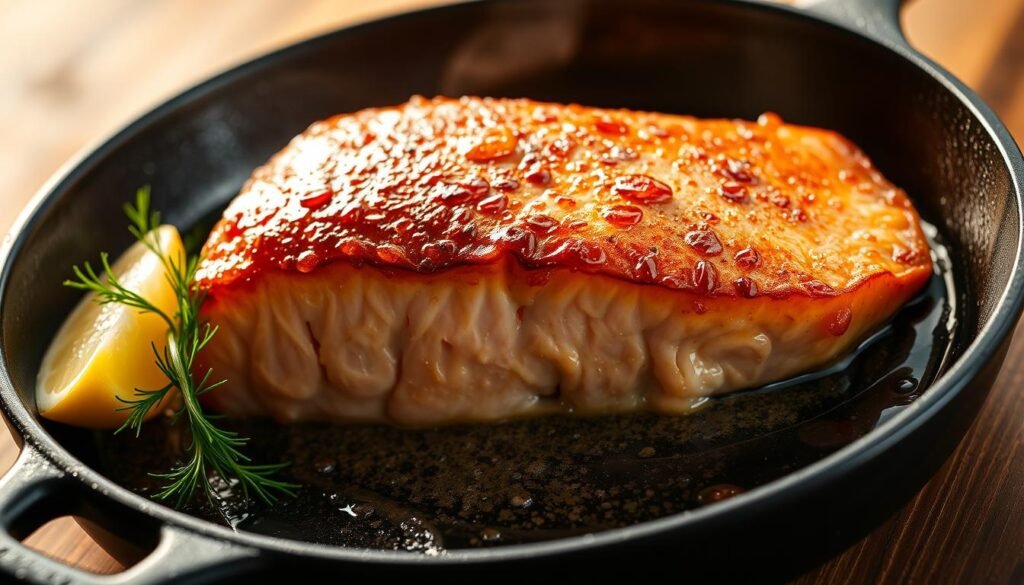
Learning how to pan-sear grilled salmon can change your cooking game. It makes your dishes taste like they’re from a fancy restaurant. The secret is knowing how to handle heat, timing, and prep.
First, pick the right pan. A heavy-bottomed skillet is best for even heat. Cast iron or stainless steel pans are great for getting that golden crust on your salmon.
- Pat the salmon dry with paper towels to ensure a crisp sear
- Season generously with salt and pepper
- Use high heat for the perfect crispy exterior
- Cook skin-side down first for maximum flavor
Cooking times depend on the salmon’s thickness. Thin fillets need 3-4 minutes per side, while thicker ones might take 5-7 minutes. You want a golden crust and a slightly soft center.
| Salmon Thickness | Cooking Time | Internal Temperature |
|---|---|---|
| Thin Fillet (1/2 inch) | 3-4 minutes per side | 125°F (medium-rare) |
| Medium Fillet (1 inch) | 4-5 minutes per side | 130°F (medium) |
| Thick Fillet (1.5 inches) | 5-7 minutes per side | 135°F (medium-well) |
Pro tip: Let your grilled salmon rest for 2-3 minutes after cooking. This helps the juices spread evenly, making it moist and flavorful. It’s sure to impress any home chef.
Flavor Combinations and Seasonings
Turning your salmon into something special starts with the right seasoning. The secret to a great salmon dish is choosing the perfect herbs and spices. These should enhance its rich, buttery taste.
Creating the perfect salmon with herbs is all about the right flavors. Your cooking can get a boost by trying out different seasoning mixes. These can make your salmon taste even better.
Herb and Spice Blends
Top chefs suggest these great salmon seasoning mixes:
- Classic Mediterranean Blend: Dried oregano, thyme, and rosemary
- Zesty Citrus Mix: Lemon zest, dill, and black pepper
- Smoky Paprika Rub: Smoked paprika, garlic powder, and sea salt
Marinade Magic
Marinating your salmon can change its taste. Quick marinades with olive oil, fresh herbs, and citrus add amazing depth and complexity.
Sauce Pairings
Try these amazing sauces with your salmon:
- Creamy dill sauce
- Honey mustard glaze
- Lemon butter sauce
Try these seasoning tips to make meals as good as a restaurant’s. Your taste buds will love it!
Baked Salmon Methods for Beginners
Learning to make baked salmon can change your cooking at home. It’s a simple yet tasty way to enjoy this healthy fish, even if you’re new to cooking. The trick is knowing the right techniques to make it moist and flavorful every time.
Begin by picking the right temperature and cooking method. Heat your oven to 375°F. This is the best temperature for cooking salmon evenly. The baking time depends on how thick your fillet is:
- Thin fillets (under 1 inch): 8-10 minutes
- Medium fillets (1-1.5 inches): 12-15 minutes
- Thick fillets (over 1.5 inches): 15-18 minutes
There are two main baking techniques for salmon:
- Foil-Wrapped Method: Wrap the salmon in foil to keep moisture in and cook it steamily.
- Open Baking Method: Put the salmon on a baking sheet for a crispy outside.
For the best baked salmon, always check the internal temperature reaches 145°F. Use a meat thermometer to make sure the fish is cooked well without drying out. With a bit of practice, you’ll be making delicious baked salmon like a pro in your kitchen.
Health Benefits and Nutritional Value
Salmon is a nutritional powerhouse that can change your diet for the better. It’s not just tasty; it’s packed with nutrients your body needs.
Exploring salmon nutrition shows it’s full of health-boosting elements. It’s a nutritional superstar with many benefits.
Omega-3 Fatty Acids: Your Heart’s Best Friend
Omega-3 fatty acids are salmon’s biggest health advantage. These nutrients offer many benefits:
- Supports heart health
- Reduces inflammation
- Promotes brain function
- Helps maintain healthy cholesterol levels
Protein and Mineral Powerhouse
Salmon is a great source of high-quality protein and minerals. Here’s what you get:
| Nutrient | Amount per 3 oz serving | Key Benefits |
|---|---|---|
| Protein | 22 grams | Muscle building and repair |
| Vitamin D | 447 IU | Bone health and immune support |
| Selenium | 31 mcg | Antioxidant protection |
| Potassium | 326 mg | Heart and muscle function |
Adding salmon to your diet is a smart health choice. Each bite brings you closer to optimal nutrition with its omega-3s, protein, and minerals.
Side Dish Pairings and Accompaniments
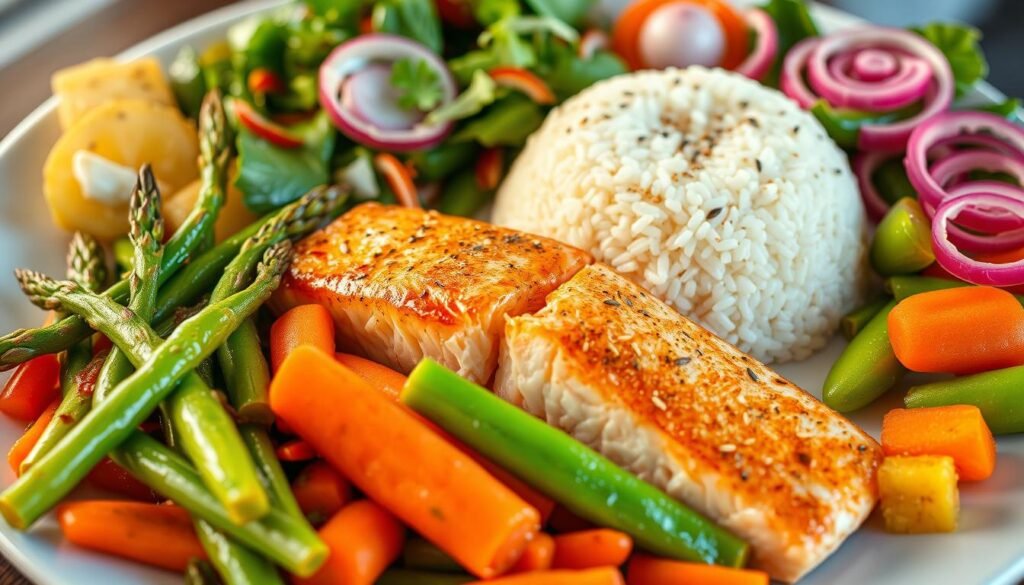
Making the perfect salmon dish is more than just the fish. The right sides can take your meal from good to great. Choosing sides that complement the flavors makes the dish complete and nutritious.
When you pair your salmon with the right sides, it really stands out. Light, fresh options bring out the fish’s rich taste and add nutrition.
- Roasted Vegetable Options:
- Asparagus
- Brussels sprouts
- Honey-glazed carrots
- Grain Accompaniments:
- Quinoa pilaf
- Wild rice blend
- Herbed couscous
Think about texture and taste when picking sides for your salmon. A crisp salad can offer a nice contrast to the soft fish.
| Side Dish Category | Recommended Pairings | Preparation Time |
|---|---|---|
| Grains | Lemon herb quinoa | 15 minutes |
| Vegetables | Roasted garlic broccoli | 20 minutes |
| Salads | Arugula with citrus vinaigrette | 10 minutes |
« The right side dish transforms a simple salmon meal into a culinary experience. » – Professional Chef
Quick tip: For light salmon, choose bright, zesty sides. For rich salmon, pick sides that are more neutral. This way, the fish’s flavor can shine.
Storage and Leftover Tips
Learning how to store salmon fillets right can keep their flavor strong and prevent waste. Fresh salmon needs careful handling to stay tasty. When you have leftover salmon, storing it properly is crucial to keep its taste and nutrients.
Here’s how to store cooked salmon fillets in the fridge:
- Store in an airtight container
- Refrigerate within 2 hours of cooking
- Consume within 3 days
- Keep at or below 40°F
Freezing salmon fillets is a great way to make them last longer. Wrap the salmon tightly in plastic wrap or foil before freezing. Put it in a freezer-safe bag, squeezing out air to avoid freezer burn. Frozen salmon can stay good for up to 3 months.
When reheating leftover salmon, be gentle to avoid drying it out. Try these methods:
- Oven method: Preheat to 275°F and warm for 10-15 minutes
- Microwave method: Use low power and heat in short 30-second intervals
- Skillet method: Warm on low heat with a splash of water
Pro tip: Leftover salmon fillets can be turned into tasty salads, pasta dishes, or quick sandwiches. This makes meal prep fun and easy!
Common Cooking Mistakes to Avoid
Cooking grilled salmon well takes practice and knowing what not to do. Common mistakes can ruin a great meal. Learning what to avoid will help you make perfect salmon dishes every time.
Grilling salmon can be tricky, but with the right tips, you’ll get it right soon. Let’s look at the main mistakes home cooks make with their favorite fish.
Temperature Control Challenges
Temperature is key when cooking salmon. Cold fish from the fridge cooks unevenly. Your marinade works best when the fish is room temperature. Here are some temperature tips:
- Remove salmon from fridge 15-20 minutes before cooking
- Pat the fish dry with paper towels
- Let it warm evenly to room temperature
- Keep the heat even to avoid uneven cooking
Seasoning Mistakes to Avoid
Seasoning right can make your grilled salmon amazing. Here are common seasoning mistakes to avoid:
- Under-seasoning makes the fish taste bland
- Too much salt hides the salmon’s taste
- Bad herb mixes can ruin the flavor
- Marinating too early or too late is a mistake
Cooking Time Precision
Timing is crucial when cooking salmon. Overcooking makes it dry and tough. Professional chefs say to cook salmon to 145°F. Look for these signs of perfectly cooked salmon:
- Flesh turns opaque and flakes easily
- Color changes to light pink
- It stays moist and tender
Avoiding these mistakes will help you make salmon that impresses everyone.
Conclusion
Diving into salmon recipes is a tasty and healthy way to make great meals. You’ve learned how to pick, prepare, and cook salmon. This will change how you cook seafood.
Learning different cooking methods like pan-searing and baking lets you make dishes like restaurants. Each recipe is a chance to try new flavors and improve your cooking. Whether you’re new or experienced, these skills will make your seafood dishes better.
Choosing salmon wisely is good for your health. Knowing the difference between wild and farm-raised salmon is key. It’s packed with nutrients that are good for your heart and brain.
Start cooking salmon today and see how easy and tasty it can be. It’s a great choice for your diet because it’s full of omega-3s and protein. Enjoy the journey of learning and making delicious meals.

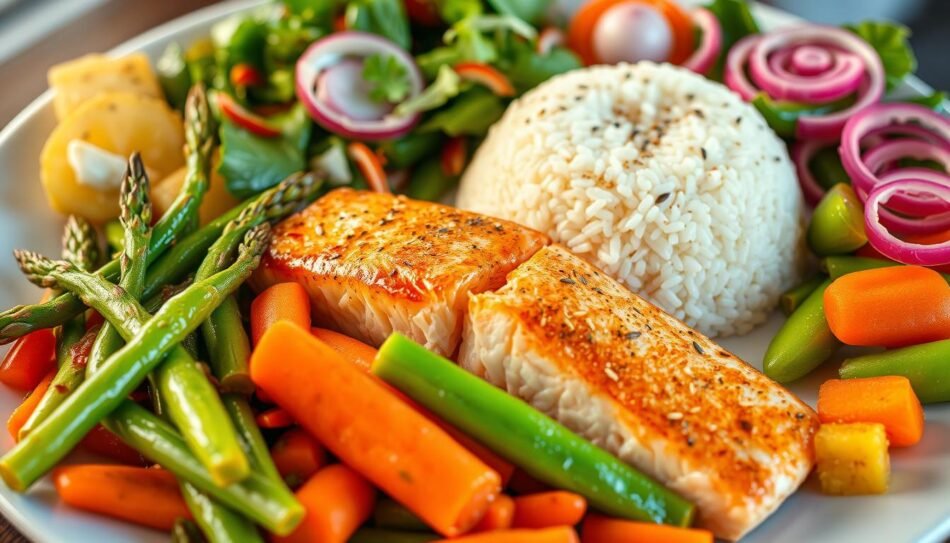




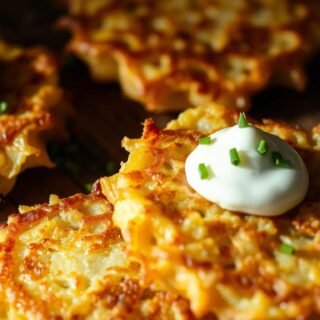
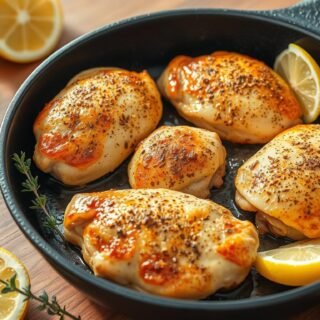
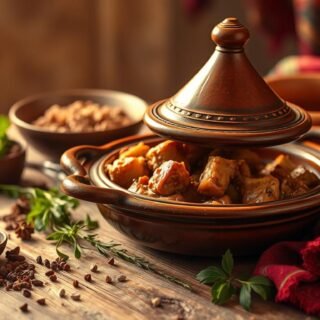
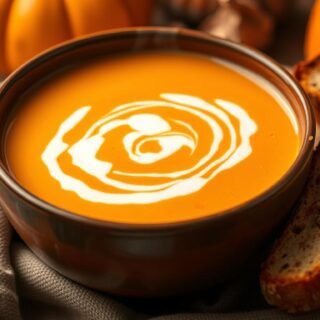
Pingback: how to cook tagin moroccan: A Step-by-Step Guide